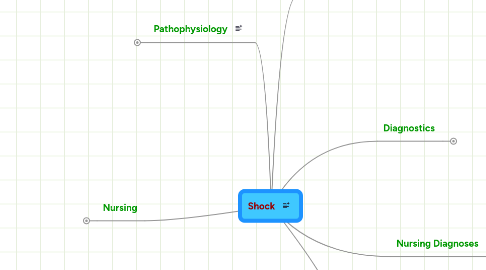
1. Pathophysiology
1.1. Low Blood Flow
1.1.1. Cardiogenic Shock
1.1.2. Hypovolemic Shock
1.2. Maldistribution of Blood Flow
1.2.1. Neurogenic Shock
1.2.2. Anaphylactic Shock
1.2.3. Septic Shock
2. Collaborative Care
2.1. Early Recognition
2.2. Correct the underlying cause
2.3. Prevent organ dysfuntion
2.4. Multisystem supportive care
3. Nursing
3.1. Oxygen and Ventilation
3.2. Fluid Resuscitation
3.2.1. Isotonic solutions
3.2.2. Hypertonic solutions
3.2.3. Blood/Bood Products
3.2.4. Colloids
3.3. Drug Therapy
3.3.1. Sympathomimetics
3.3.1.1. epinephrine (Adrenalin)
3.3.2. Vasodilators
3.3.2.1. nitroglycerin (Tridil)
3.3.2.2. nitroprusside (Nipride)
3.3.3. Vasopressors
3.3.3.1. norephinephrine (Levophed)
3.3.3.2. dopamine (Intropin)
3.3.4. Antibiotics?
3.3.5. Inotropics
3.3.5.1. dobutamine (Dobutrex)
3.3.5.2. dopamine (Intropin)
3.3.6. Anticoagulation?
3.4. Nutritional Therapy
3.4.1. Enteral
3.4.2. Parenteral
3.5. Circulation
3.5.1. IABP
4. Signs & Symptoms
4.1. stages of shock
4.1.1. Intital
4.1.2. Compensatory
4.1.3. Progressive
4.1.4. Refractory
4.2. body systems
4.2.1. Renal
4.2.1.1. decreased urine output
4.2.2. Cardiovascular
4.2.2.1. decreased cardiac output
4.2.3. Neurologic
4.2.3.1. alteration in mental status
4.2.4. Pulmonary
4.2.4.1. hypoxia
5. Diagnostics
5.1. Lab
5.1.1. CBC
5.1.2. Cultures
5.1.2.1. Blood
5.1.2.2. Urine
5.1.2.3. Sputum
5.1.3. ABG's
5.1.4. DIC screen
5.1.4.1. Ptt and PT
5.1.4.2. platelet count
5.1.5. BUN and creatinine
5.1.6. glucose
5.1.7. electrolytes
5.1.7.1. Na+, K+
5.1.8. liver enzymes
5.1.8.1. ALT, AST, GGT
5.1.9. urine
5.1.9.1. specific gravity
5.1.10. CXR
5.1.11. 12-lead EKG
6. Nursing Diagnoses
6.1. Inneffective tissue perfusion r/t
6.1.1. low blood flow
6.1.2. maldistribution of blood
